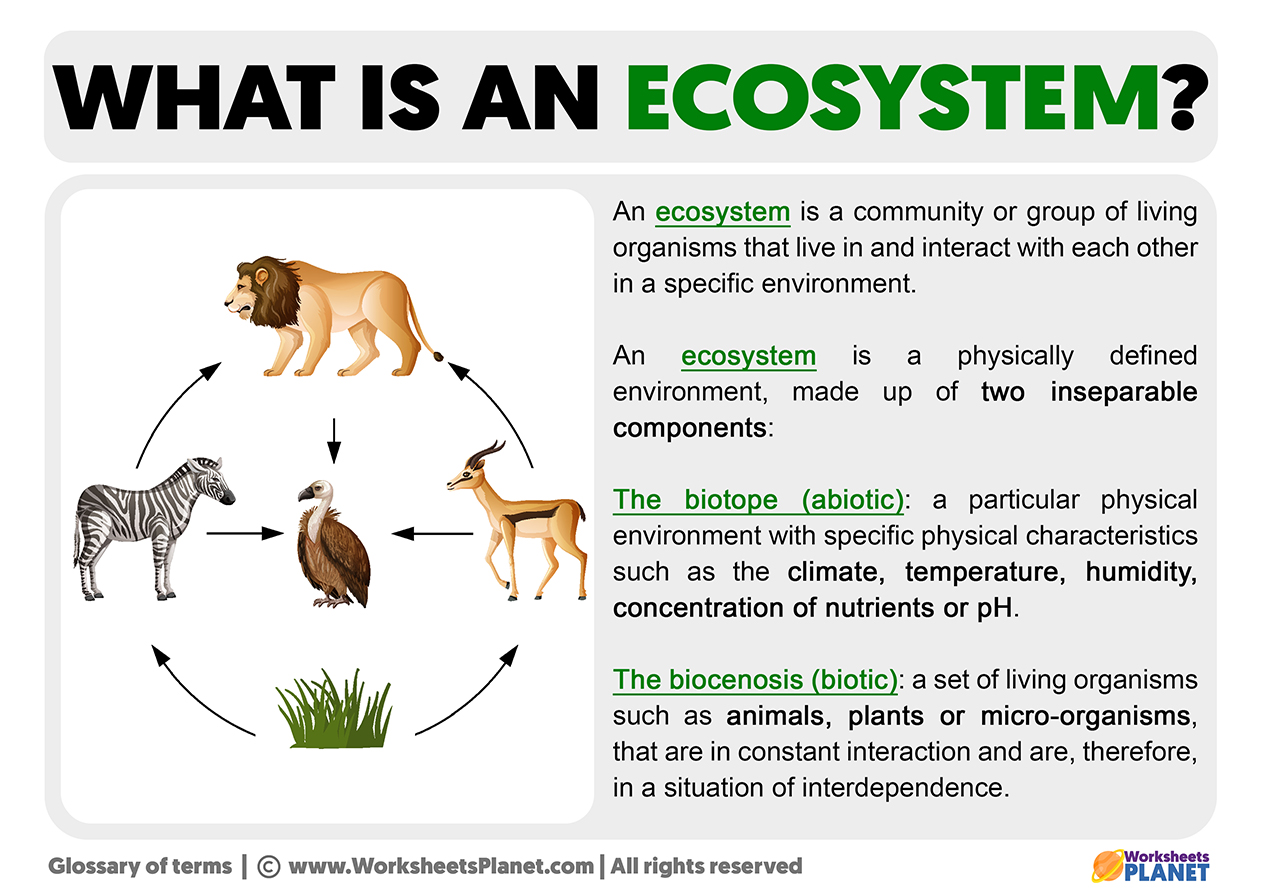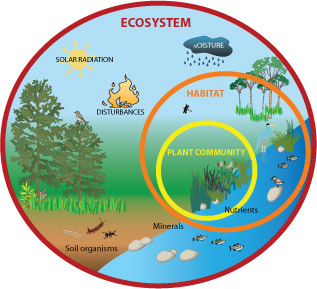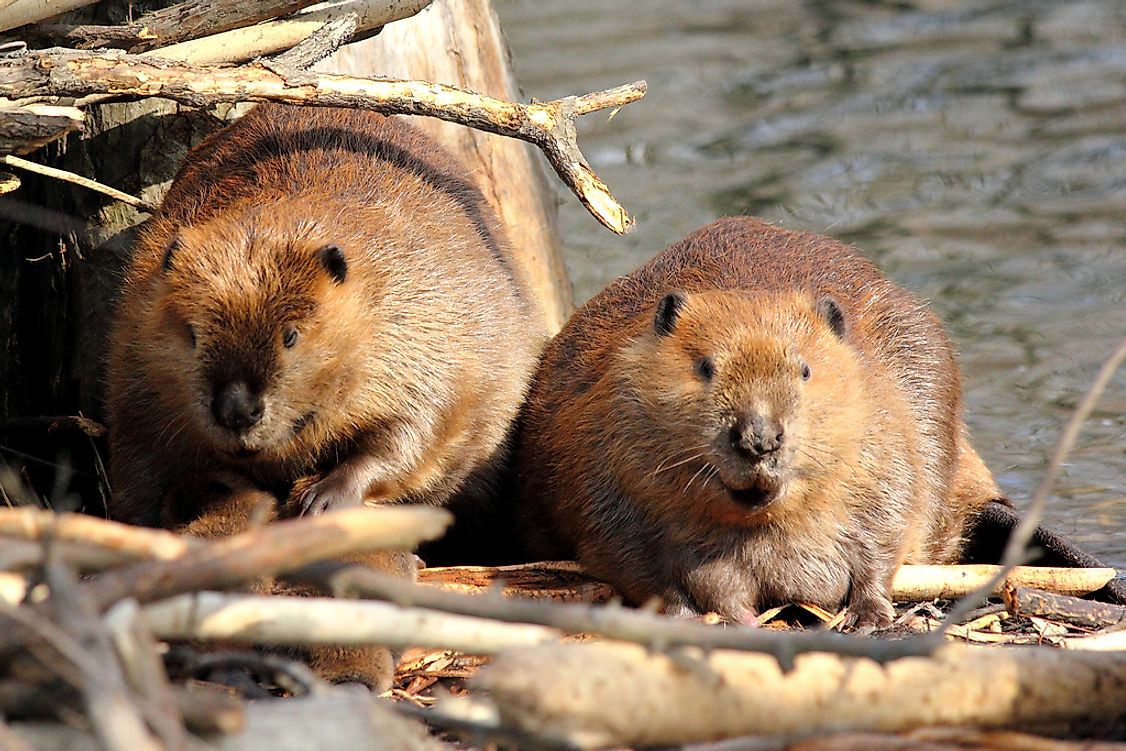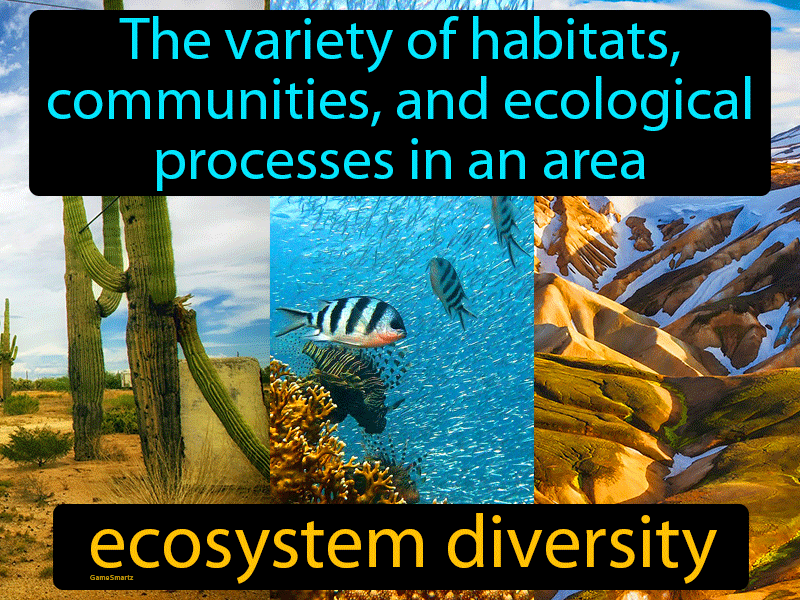Topic define an ecosystem: Explore the fascinating world as we define an ecosystem, a dynamic complex where plants, animals, and microorganisms interact with their environment, forming a life-supporting network of relationships.
Table of Content
- What is an ecosystem and how do plants, animals, and other organisms interact within it?
- What is an Ecosystem?
- Components of an Ecosystem
- Types of Ecosystems
- Ecosystem Processes: Energy Flow and Nutrient Cycles
- YOUTUBE: What Is an Ecosystem
- The Importance of Biodiversity in Ecosystems
- Ecosystem Services to Humans
- Human Impact on Ecosystems
- Conservation and Restoration of Ecosystems
What is an ecosystem and how do plants, animals, and other organisms interact within it?
An ecosystem is a complex network of interactions between living organisms (plants, animals, microorganisms) and their physical environment. These interactions are vital for the functioning and stability of the ecosystem. Here is how plants, animals, and other organisms interact within an ecosystem:
- Energy Flow: Plants, as primary producers, harness energy from the sun through photosynthesis. They convert this energy into organic compounds that are consumed by herbivores (plant-eating animals). Herbivores are then consumed by carnivores (meat-eating animals), forming a food chain.
- Nutrient Cycling: Decomposers such as bacteria and fungi break down dead organic matter into nutrients like nitrogen and phosphorus. These nutrients are then recycled back into the ecosystem, benefiting plants and contributing to their growth.
- Habitat and Shelter: Different organisms create diverse habitats within an ecosystem. For example, trees provide shelter for birds, insects, and other small animals, while burrowing animals like rabbits create homes for themselves and aerate the soil.
- Competition: Organisms within an ecosystem compete for resources such as food, water, and territory. This competition can lead to natural selection, where individuals with advantageous traits survive and reproduce.
- Mutualism: Some species form mutually beneficial relationships within an ecosystem. For example, pollinators like bees benefit from nectar while transferring pollen, aiding in plant reproduction.
Overall, the interactions of plants, animals, and other organisms within an ecosystem are interconnected and essential for maintaining the balance and sustainability of the ecosystem.
READ MORE:
What is an Ecosystem?
An ecosystem is a community of living organisms in conjunction with the nonliving components of their environment, interacting as a system. These biotic and abiotic components are linked together through nutrient cycles and energy flows. Ecosystems can be as large as a desert or as small as a puddle. The functioning of an ecosystem relies on the intricate relationships between its organisms, including plants, animals, and microorganisms, and the physical environment they inhabit.
- Biotic Components: The living parts of an ecosystem, such as plants, animals, fungi, and microorganisms. They interact with each other and their nonliving environment.
- Abiotic Components: The nonliving, physical and chemical aspects of an ecosystem, including sunlight, soil, water, air, and nutrients. These elements help shape the habitat and influence the life processes of biotic components.
Ecosystems are dynamic entities; they are subject to periodic disturbances and are in constant flux, adapting to environmental changes. The health and sustainability of an ecosystem depend on the balanced interaction between its biotic and abiotic components.

Components of an Ecosystem
Ecosystems consist of various biotic and abiotic components that interact with each other to sustain life. Understanding these components is key to comprehending how ecosystems function and the importance of each element in maintaining ecological balance.
Biotic Components
- Producers (Autotrophs): These are organisms that can produce their own food through photosynthesis or chemosynthesis, forming the base of an ecosystem"s food web.
- Consumers (Heterotrophs): Organisms that cannot produce their own food and rely on other organisms for nutrition. Consumers are categorized into primary, secondary, and tertiary consumers, based on their role in the food chain.
- Decomposers: They break down dead organisms and waste materials into simpler substances, recycling nutrients back into the ecosystem.
Abiotic Components
- Water: Essential for life, water is a medium for chemical reactions in organisms and a habitat for aquatic life.
- Soil: It supports plant life and is the home to many organisms. Soil composition affects the types of plants that can grow, influencing the entire ecosystem.
- Air: Provides oxygen for respiration and carbon dioxide for photosynthesis, playing a crucial role in the energy exchange within the ecosystem.
- Sunlight: The primary source of energy for ecosystems, driving photosynthesis and determining the climate of the region.
- Nutrients: Chemical elements like nitrogen, phosphorus, and potassium are vital for the growth of organisms. Nutrient cycling maintains the health of the ecosystem.
Together, these components interact in complex ways to sustain the ecosystem, making it a dynamic and integrated system of life.
Types of Ecosystems
Ecosystems are diverse and vary widely across the globe, each supporting unique forms of life and environmental conditions. They can be broadly classified into two main types: terrestrial and aquatic ecosystems, each with their own sub-types that exhibit distinct characteristics and support various species of plants and animals.
Terrestrial Ecosystems
- Forests: Characterized by a high density of trees, forests are critical for supporting a vast biodiversity of plants and animals. They are further divided into tropical, temperate, and boreal forests.
- Deserts: These ecosystems are known for their extreme dryness, sparse vegetation, and wide temperature variations between day and night. Animal and plant life have adapted to survive with minimal water.
- Grasslands: Dominated by grasses, these areas support a variety of herbivores, predators, and migratory animals. Grasslands include the savannas of Africa and the prairies of North America.
- Tundra: Characterized by cold temperatures, permafrost, and minimal tree growth, the tundra is home to hardy species of animals and plants adapted to its harsh conditions.
Aquatic Ecosystems
- Freshwater Ecosystems: Including rivers, lakes, ponds, and streams, these ecosystems are vital for the survival of many species, including humans, for drinking water, agriculture, and habitat.
- Marine Ecosystems: Covering most of the Earth"s surface, marine ecosystems include oceans, coral reefs, and estuaries. They support a diverse array of life and are essential for global climate regulation.
- Wetlands: Areas where water is present at or near the surface of the soil for part of the year. Wetlands are crucial for water purification, flood protection, and supporting unique plant and animal life.
Understanding the different types of ecosystems helps in appreciating the diversity of life on Earth and the importance of conservation efforts to protect these vital systems.

Ecosystem Processes: Energy Flow and Nutrient Cycles
Ecosystem processes, including the flow of energy and the cycling of nutrients, are fundamental for the maintenance and sustainability of ecosystems. These processes ensure that energy is transferred through different levels of an ecosystem and that nutrients are recycled, supporting life across various forms.
Energy Flow
Energy in an ecosystem flows in a linear direction, from the sun to producers and then through various levels of consumers before being lost as heat. This flow of energy is critical for the functioning of ecosystems, supporting the complex food webs that sustain life.
- Producers: Capture solar energy through photosynthesis, converting it into chemical energy in the form of glucose.
- Consumers: Obtain energy by consuming other organisms, transferring energy up the food chain.
- Decomposers: Break down dead organisms, releasing nutrients back into the ecosystem and completing the energy flow cycle.
Nutrient Cycles
Nutrient cycles, such as the carbon, nitrogen, and phosphorus cycles, involve the movement and exchange of essential nutrients between the biotic and abiotic components of an ecosystem. These cycles are crucial for maintaining the health and productivity of ecosystems.
- Carbon Cycle: Describes the movement of carbon between the atmosphere, organisms, and the earth, essential for life.
- Nitrogen Cycle: Involves the conversion of nitrogen into forms usable by plants and animals, crucial for protein and DNA synthesis.
- Phosphorus Cycle: Manages the movement of phosphorus through the ecosystem, vital for cell membranes and energy transfer.
Together, the flow of energy and nutrient cycles create a dynamic, interconnected system that sustains life on Earth, highlighting the importance of preserving these delicate processes through conservation efforts.
What Is an Ecosystem
Biodiversity: Discover the wonders of our planet\'s rich biodiversity in this captivating video showcasing the beauty and importance of diverse ecosystems. Experience the vibrant array of life forms that coexist harmoniously in nature. Interaction: Dive into the fascinating world of interaction in this intriguing video exploring how different species communicate, cooperate, and depend on each other for survival. Witness the interconnected web of relationships that shape our dynamic ecosystems.
Ecosystem Definition
See here, the definitions of the word ecosystem, as video and text. (Click show more below.) ecosystem (noun) A system formed ...
The Importance of Biodiversity in Ecosystems
Biodiversity, or the variety of life in the world or in a particular habitat or ecosystem, plays a crucial role in the health and functionality of ecosystems. It ensures resilience to environmental changes and supports the multitude of ecosystem processes that make life possible.
- Supports Ecosystem Services: Biodiversity contributes to the provision of essential ecosystem services such as air and water purification, pollination of plants, and regulation of the climate.
- Enhances Food Security: A diverse genetic pool ensures the resilience of crops and livestock to pests, diseases, and climate change, contributing to food security and agricultural sustainability.
- Promotes Health: Biodiversity is key for medicinal research and provides many compounds that form the basis of pharmaceuticals. Diverse ecosystems also support mental health by providing natural spaces for recreation and relaxation.
- Maintains Ecosystem Balance: The interaction and interdependence of different species ensure natural sustainability for all life forms. Predators, prey, and plants form a complex web that maintains the balance of ecosystems.
The preservation of biodiversity is therefore essential for the sustainability of our planet. It supports economic prosperity through its direct contributions to agriculture, medicine, and industry, as well as its indirect contributions to ecosystem services that are not easily replaced. As such, protecting biodiversity is crucial for ensuring a sustainable and resilient environment for future generations.

Ecosystem Services to Humans
Ecosystem services are the many and varied benefits that humans freely gain from the natural environment and from properly-functioning ecosystems. Such ecosystems include, for example, agroecosystems, forest ecosystems, grassland ecosystems and aquatic ecosystems. Collectively, these benefits are becoming increasingly recognized as essential for human survival and economic prosperity. Ecosystem services are grouped into four main categories: provisioning, regulating, cultural, and supporting services.
Provisioning Services
- Food Production: Ecosystems provide the conditions for growing food. Crops, livestock, and seafood are all examples of food produced with the help of ecosystems.
- Water Supply: Freshwater ecosystems supply drinking water, irrigation for agriculture, and the raw water supply for industrial processes.
- Raw Materials: Forests provide timber, fibers, and other materials; ecosystems also supply non-timber products like latex, resins, and more.
Regulating Services
- Climate Regulation: Ecosystems play a key role in sequestering carbon dioxide and regulating global and local climates.
- Flood Regulation: Wetlands and forests mitigate the effects of floods by absorbing excess water during storm events.
- Disease Regulation: Healthy ecosystems can control diseases through regulating the populations of pathogens and vectors.
Cultural Services
- Recreational Opportunities: Natural parks and wild spaces provide areas for recreation and tourism, contributing to physical and mental well-being.
- Aesthetic Value: The beauty of natural landscapes has inspired artists and writers and contributes to human enjoyment and spiritual well-being.
- Educational Value: Ecosystems and their processes provide invaluable opportunities for learning and scientific research.
Supporting Services
- Nutrient Cycling: The recycling of nutrients is vital for supporting the conditions of life on Earth.
- Soil Formation: Ecosystems contribute to the formation of soil, which is crucial for agriculture and the regulation of Earth"s surface processes.
Understanding and preserving ecosystem services is crucial for sustaining human life and ensuring the well-being of communities around the globe.
Human Impact on Ecosystems
Human activities have profound impacts on ecosystems, altering their structure, function, and services they provide. While some impacts are beneficial, many are detrimental, threatening the health of the planet and the well-being of future generations. Understanding these impacts is crucial for developing sustainable practices that support ecosystem health and human prosperity.
- Land Use Change: Urbanization, agriculture, and deforestation have transformed natural landscapes, leading to habitat loss, decreased biodiversity, and altered ecosystem functions.
- Pollution: Air, water, and soil pollution from industrial activities, agriculture, and waste disposal disrupt ecosystems by introducing harmful substances that affect wildlife and human health.
- Climate Change: The release of greenhouse gases from burning fossil fuels and deforestation is altering global climate patterns, impacting ecosystems through temperature rises, altered precipitation patterns, and more frequent extreme weather events.
- Overexploitation: The excessive harvesting of resources, such as overfishing and unsustainable logging, depletes biodiversity and disrupts ecosystem services.
- Invasive Species: The introduction of non-native species can outcompete, predation, or bring diseases to native species, leading to shifts in ecosystem balance and function.
Addressing these impacts requires a concerted effort from governments, communities, and individuals to adopt sustainable practices, protect natural habitats, and restore damaged ecosystems. By recognizing our interconnectedness with nature, we can work towards a future where both human and ecological communities thrive.

READ MORE:
Conservation and Restoration of Ecosystems
The conservation and restoration of ecosystems are vital efforts aimed at preserving biodiversity, sustaining ecosystem services, and reversing the damage caused by human activities. These efforts are essential for maintaining the health of our planet and ensuring a sustainable future for all species, including humans.
- Protected Areas: Establishing national parks, wildlife reserves, and marine protected areas to conserve biodiversity and protect ecosystem services.
- Sustainable Practices: Promoting sustainable agriculture, forestry, and fishing practices to reduce environmental impacts and maintain ecological balance.
- Restoration Projects: Undertaking ecosystem restoration projects, such as reforestation, wetland restoration, and coral reef rehabilitation, to repair damaged ecosystems and enhance biodiversity.
- Climate Change Mitigation: Implementing strategies to reduce greenhouse gas emissions and enhance carbon sequestration, helping to mitigate climate change and its effects on ecosystems.
- Community Involvement: Engaging local communities in conservation efforts, recognizing their knowledge and needs, and fostering a sense of stewardship for the environment.
- Policy and Legislation: Developing and enforcing environmental laws and policies that promote conservation, protect endangered species, and regulate resource use.
Through these and other efforts, we can work towards a more sustainable interaction with our natural environment, preserving it for future generations while reaping the benefits it provides. The conservation and restoration of ecosystems is not just an environmental imperative but also a moral one, recognizing our responsibility to the planet and its inhabitants.
Exploring ecosystems reveals the intricate balance of life, underscoring our responsibility to protect these vital systems. By understanding and preserving ecosystems, we safeguard our future, ensuring a thriving planet for generations to come.












